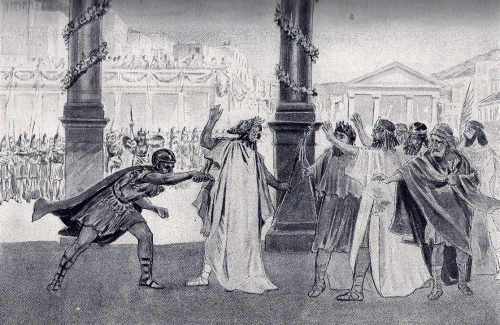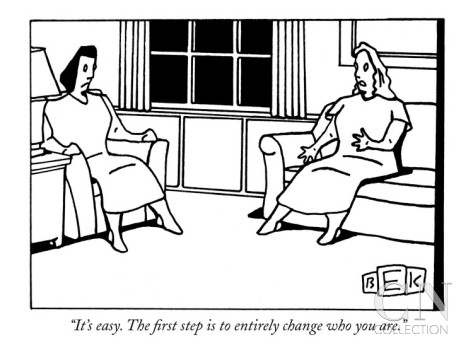
 A few decades before Alexander’s conquest, the Macedonians were considered barbarous and uncivilized by the other Greeks. Many of their nobles felt they should be proper Greeks, and one young king in particular – Alexander the Great’s father, Philip – seems to have been very bothered by the discrepancies between the Macedonians’ actual status as outsiders and their desired identity as insiders. Philip addressed this discrepancy by transforming, in a few short decades, his backward country into a military powerhouse and conquering the snobbish Greeks. Near the end of his life, he held a Pan-Hellenic festival to celebrate the new order of Macedonian dominance. To demonstrate the goodwill of his subjects, he entered the arena without his bodyguards, unprotected, knowing people’s love and respect would shield him. Ironically, leaving the bodyguards behind may have almost saved his life; after entering the arena, one of the guards himself ran forward and assassinated him.
A few decades before Alexander’s conquest, the Macedonians were considered barbarous and uncivilized by the other Greeks. Many of their nobles felt they should be proper Greeks, and one young king in particular – Alexander the Great’s father, Philip – seems to have been very bothered by the discrepancies between the Macedonians’ actual status as outsiders and their desired identity as insiders. Philip addressed this discrepancy by transforming, in a few short decades, his backward country into a military powerhouse and conquering the snobbish Greeks. Near the end of his life, he held a Pan-Hellenic festival to celebrate the new order of Macedonian dominance. To demonstrate the goodwill of his subjects, he entered the arena without his bodyguards, unprotected, knowing people’s love and respect would shield him. Ironically, leaving the bodyguards behind may have almost saved his life; after entering the arena, one of the guards himself ran forward and assassinated him.
The discrepancy between our actual selves and the selves we want to be drives many of our actions, which are aimed toward closing that gap, and many of our bad choices come from neglecting this discrepancy, over-estimating our virtues, discipline, or abilities. This ‘discrepancy’ has long been a theme in Christianity, which made it all the more surprising when I discovered, while rifling through a psych journal, an entire theory (“self-discrepancy theory”) dealing with how we relate to our better selves.
In short, earlier psychologists had assumed that motivation, to simplify only somewhat, derived from a carrot-stick dichotomy: pursuing pleasure and avoiding pain. E. Tory Higgins, on the other hand, deepened the study of motivation by suggesting people are motivated by discrepancies between their actual self and other, more desirable selves. The main paper dealing with this theory appeared in the Psychological Review in 1987, accessible here. Some highlights quoted and/or summarized below:
There are three basic domains of the self: (a) the actual self, which is your representation of the attributes that someone (yourself or another) believes you actually possess; (b) the ideal self, which is your representation of the attributes that someone (yourself or another) would like you, ideally, to possess (i.e., a representation of someone’s hopes, aspirations, or wishes for you); and (c) the ought self, which is your representation of the attributes that someone (yourself or another) believes you should or ought to possess (i.e., a representation of someone’s sense of your duty, obligations, or responsibilities)…

So we can divide identity tensions into four groups: the struggles between my actual self and my wished-for self, between my actual self and the self others wish I could be, between my actual self and the self I think I ought to be, and between my actual self and the self others think I ought to be. So my current, actual self feels judgment and/or condemnation by four ‘alternate’, or possible, selves: who I want to be, who others want me to be, who I feel I ought to be, and who others feel I ought to be.
Most people, it seems, will focus on one or other of these tensions. Are you someone with high ambitions (1), or someone who wants to make everyone around you happy (2)? Someone who feels like you’re disappointing your own moral/spiritual code (3), or disappointing others’ (4)? Higgins suggests that if you’re type 1, your emotional discomfort will frequently include dejection and dissatisfaction; if 2, embarrassment and shame; if 3, guilt and uneasiness; if 4, fear and vulnerability. It’s important to note that in all four cases, something legitimately good is being thwarted: my desires, the desires of those around me, my moral ideals, and the moral ideals of those around me.
So these possible selves aren’t bad things at all; rather, they’re reminders of humanity as it was meant to be, anticipations of the eschaton, and expressions of human aspiration. The problem isn’t these possible selves; it’s the ways we try to close this gap. In religious terms, someone who’s constantly disappointing the desires of others will try to close the gap by fleeing them: +1 child in Portland. Someone who feels they’re disappointing moral expectations will flee them, too: the familiar story of fundamentalists becoming atheists, and (much less common) vice-versa. Sometimes, we just try really, really hard to meet whichever of the four standards is most important to us. Often, we can gauge how poorly or how well we’re living up to them by the prevalence or absence of Higgins’s emotional discomforts.

A Christian perspective may clear some ground to critique Higgins on a few points: after all, Christianity has implicitly understood “self-discrepancy” at the very least since Luther, the Reformation’s great patient. For one, our desires are implicitly oriented toward the good (Augustine, Aquinas, etc etc etc) – however marred our notion of it is – so a sharp distinction between desires and oughts should be questioned. Often, desires are refracted oughts, and vice-versa. In this view, everyone struggles with the voice of ‘ought’, regardless of which self-discrepancy category they fall into.
Second, just as much as people are motivated by closing these gaps, they’re also motivated – counterintuitively – by widening them. One of Luther’s mechanisms for how the Law works was that the Law threatens independence, and thus people resent the Law. Everyone has that friend who’s less likely to see a movie after you recommend it to them; if not, that friend’s probably you (it’s me, too – it’ll be decades, at this rate, before Les Choristes makes the queue). In the short run, we’ll do our best to live up the standards, but in the long run, we’ll either flee from them (Portland again) or try to break them (a causes biggest opponents are often its disillusioned old adherents). Higgins’s suggestion that we largely are motivated by self-discrepancy seems right, but the actual self trying to bridge the gap can’t work; if it could, the actual and ideal selves would be identical. If these self-discrepancies really are the source of much emotional discomfort, and the solution cannot be the actual self moving upward, then it must be the opposite. In Protestant Christianity, the gap closes by two distinct moments:
1. The ‘ought’ self, far from being attained, is freely given, paralleling the movement of the perfect ‘ought’ man coming down from heaven and dying at the hands of history’s fallen ‘actuality’. The perfect ‘ought’ cannot really be used to describe the actual, so the ‘ought’ dies a death in the process of descending; on Easter Sunday, however, we learn that the ‘ought’ mysteriously lives, and righteousness can truly be said of those who are unrighteous. The impossible unity of fallen ‘actual’ and perfect ‘ought’ finds highest expression in the hypostatic union; our ‘ought’ comes from our participation, via Christ’s humanity, in his righteousness.
2. The ideal, or desired, self becomes increasingly natural: the Spirit gives us new desires and increased means to fulfill the law. The ideal tends more toward the ought, and the gap decreases. The second moment occurs only by way of the first, and is not usually recognizable, performable, or coercible. Since the gap is closed only in the future in this case, but actually in the first case, burnout and Higgins’s emotional discomforts are still possible.
So where do you fall in Higgins’s classifications? How do we flee that standard, fight it, or appease it? And how do our own disappointments lead us to force those standards on others? The ‘ought’ gap is closed, and we look forward to the day when all will be made new, and he wipe every tear from their eyes.

COMMENTS
2 responses to “Resolving the Discrepancies of the Self”
Leave a Reply













Great post, Will. This is the other half of the story, so to speak, that needed to be said after my Kierkegaard post from a few weeks ago. Anyway, great work, and thanks for the insights.
I agree w/ Brandon, Will has a great handle on the balance between our God provided sanctification-justification selves, and our corresponding freedom to miserably fail/succeed horizontally – and the 2 posts Brandon refers to reflects it.